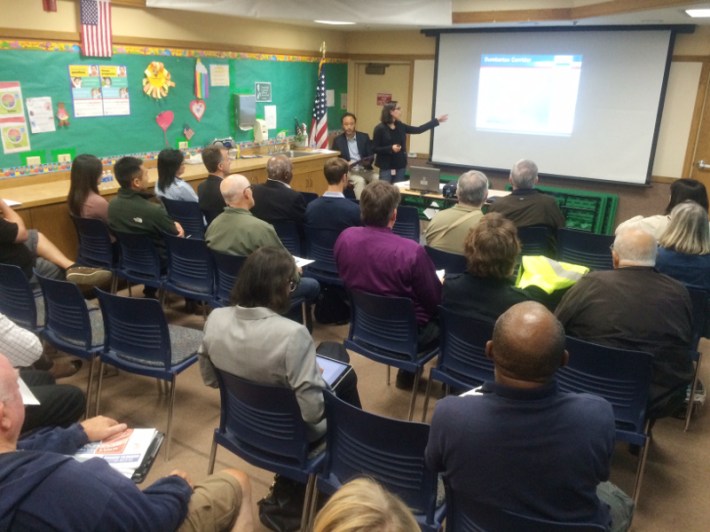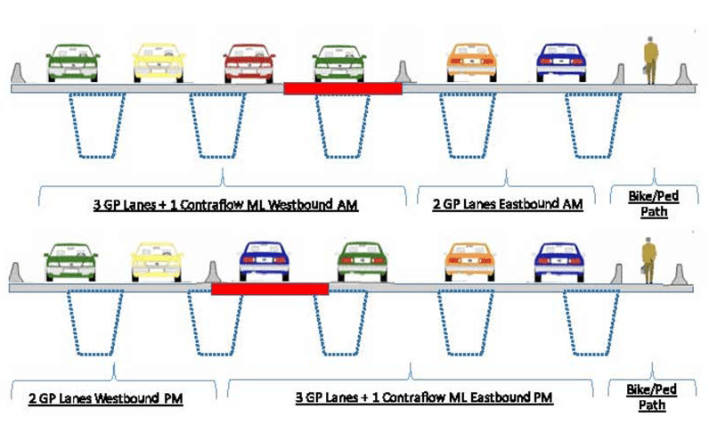
SamTrans officials presented an update on the agency’s Dumbarton Transportation Corridor Study at two community meetings this week, fielding questions from residents on ways the agency is hoping to provide better transit service over the Dumbarton Bridge. Facebook donated $1 million to the agency in January for the transportation study, which it hopes can expand commute options for its workers and cut traffic near the company's Menlo Park headquarters on Willow Road.
While the long-envisioned Dumbarton Rail project to rebuild a cross-Bay rail bridge to carry passenger trains between Redwood City Caltrain and Union City BART is still alive in the study as a long-term (2030) option, a more frequent and expanded Dumbarton Express bus service tops the agency’s list as the most effective improvement that can be funded and implemented within five years.
“The cost of the [rail] bridge rehab ranges from $330 to $348 million in 2011 dollars, which would be up using 2016 dollars,” said Principal Planner Melissa Reggiardo at Monday's community meeting in Newark.
An expanded Dumbarton Express bus service would consist of two routes connecting the Union City BART Station to Caltrain stations in Redwood City, Mountain View, and Sunnyvale. Physical upgrades to speed bus travel might include transit-signal priority and queue jump lanes at intersections, direct access on-ramps to the highway for buses and carpools, and possibly even new bus-only lanes.
“Travel times are painfully slow. People will only get on [the bus] if the ride is sped up and a little more competitive with auto travel. We see that as key,” said Reggiardo.

But SamTrans is also considering major auto traffic capacity expansions on the Dumbarton Bridge itself and on the highway approaches to the bridge. The agency assumes that capacity expansions will alleviate rush-hour traffic congestion and allow buses to travel faster, rather than inducing demand for more driving over the bridge and jamming it up with even more traffic.
SamTrans says that by 2020, several alternative lane configurations could be installed and will be studied in detail for their impact on traffic flow: reversible center lanes to provide four lanes in the peak-travel direction, carpool lanes, and express (toll) lanes. The Ardenwood Park & Ride lot could be expanded again for more cars, though it was rebuilt from 100 to 350 parking spaces in 2009.
A number of ways to speed access for drivers through the Dumbarton Bridge toll plaza on its east end are in the new study, including longer toll lanes to fit more traffic, “open road tolling” which would remove the toll booths, and constructing new direct access on-ramps for carpool and buses to connect Newark Boulevard and Highway 880 to the toll plaza.
Despite the study’s officially stated goals to pursue cost-effective improvements that enhance mobility, minimize environmental impacts, and protect low-income and minority populations, even bigger highway expansions costing hundreds of millions of dollars are on the table.

“We’re looking at grade separations of Bayfront at Willow and University on the Peninsula, and we're looking at Willow Road express lanes from the previous 2020 Gateway Study," said Reggiardo. "We would likely be looking at some sort of depressed express lanes in that area.”
That 2008 study [PDF] proposed “a depressed trench structure below Willow Road… beginning with underground portals at Highway 101 and ending with underground portals on Bayfront Expressway east of Willow Road.” This one-mile underground roadway expansion would cost an estimated $373 million in 2006 dollars and require the relocation of the Hetch-Hetchy water pipelines.
Grade separating the Bayfront Expressway intersections of Willow Road and University Avenue would require new overpasses and ramps, consuming even larger areas for auto traffic and creating additional lanes for people walking and bicycling to cross.
The new Dumbarton Corridor Study also considers a new bike/ped path and possibly bus lanes along the south side of the Dumbarton Rail tracks between Redwood City Caltrain Station and Willow Road, concepts favored by Facebook to deliver workers to its growing headquarters. SamTrans reports that a 100-foot wide swath of lane is available on the south side of the tracks, although it’s unknown if any obstructions would prevent the installation of a path or bus lanes.
SamTrans planners will analyze the alternatives selected for more detailed review and present their recommendations along with a funding plan for a set of preferred improvements in April 2017.





